X
wikiHow is a “wiki,” similar to Wikipedia, which means that many of our articles are co-written by multiple authors. To create this article, 9 people, some anonymous, worked to edit and improve it over time.
This article has been viewed 20,669 times.
Learn more...
In figure skating, stopping is one of the initial moves beginners learn during their first few classes. There are a few different kinds of skating stops, but the snowplow stop is one of the most basic and useful stopping techniques for any ice skater.
Steps
Part 1
Part 1 of 3:
Practicing The Snowplow Movements on The Rink Barrier
-
1Mimic the snowplow movement with one foot. Skate to the side of the ice rink and hold on tightly with one hand. Stand next to the rink barrier, and have your feet parallel to the barrier siding. Slightly bend your knees and position your feet about 5 inches apart. Put most of your weight on your barrier side foot. With the foot closest to the inside of the ice rink, push your foot away from you, shaving off the top layer of the ice with the inside edge of your skate blade. Move your ice side foot about 6 inches away from your body before bringing it back to center, and pushing it away from your body again.
- You will know you are doing this correctly if a pile of shaved ice forms after pushing your foot away from you.[1]
- Keep your ice side foot straight and parallel to the rink barrier as you push it away from you. Keep your barrier side foot parallel to the rink barrier as well.
-
2Mimic the snowplow movement with your other foot. After snowplowing with one foot, switch the direction you're facing so that the opposite side of your body is now closest to the rink barrier. For example, if you started out holding the barrier with your right hand and pushing your left foot away from you, turn around and hold the barrier with your left hand, working on snowplowing with your right foot. Again, start with your feet about 5 inches apart and parallel to the rink barrier. Apply most of your weight to your barrier side foot, and gently push your ice side foot away from your body about 6 inches, scraping away the top layer of ice with the inside edge of your skate blade.
- Bring your foot back to center and continue practicing the snowplow movement.
- A small pile of shaved ice should accumulate from scraping your skate across the ice.
Advertisement -
3Practice snowplowing with both feet. Now that you've practiced snowplowing both feet individually, it's time to bring it together. While holding onto the rink barrier with one hand, center your body weight evenly between both of your skates, with your feet about 5 inches apart. Slightly bend your knees and push both feet out and away from your center at the same time.[2] Your feet should move away from your center equally, resulting in your feet being about 1 ½ to 2 feet apart.
- Bring your feet back into center, and practice a few more times until you can push your feet away from your center swiftly, while keeping your feet parallel.
- Again, as you scrape your skates across the ice, small piles of shaved ice should form at the stopping point of your skates.
- Be sure to keep your feet parallel to each other as you move them away from your center, or else you might force yourself to move backward.
Advertisement
Part 2
Part 2 of 3:
Snowplowing With One Foot
-
1Skate forward. Use both of your feet to skate forward, gaining speed. You don't need to skate too fast, but you do need forward momentum so you can properly snowplow and stop moving.
-
2Parallel your feet. When you have gained enough speed, stop moving your feet, slightly bend your knees, and glide forward with your feet parallel to each other.[3] At this point, shift your body weight to one of your feet. The foot you shift your weight to is going to be the foot you keep straight as you perform your one-footed snowplow with the other foot.
- Consider shifting your weight to your non-dominant foot as you first practice the one-footed snowplow. For example, if you are a righty, try shifting your weight to your left foot, and perform the snowplow with your right foot.
-
3Turn one foot inward. This stop is also called the T-stop.[4] As you're gliding forward with your feet parallel and your body weight on one foot, turn your other foot inward. As you turn your foot inward (pointing your toes in and pushing your heel out), slightly push that foot away from your body, keeping your other foot straight. Your slanted, turned in foot will snowplow with the inside edge of your skate blade, causing you to slow down and stop.
- Be sure to keep the foot you're turning inward close to your body as you push it away. You only need to push it about 6 inches away from your center to start slowing down.
- If you push that foot out too far from your body, you'll lose control and over stretch your leg, possibly injuring yourself.[5]
- It may help to have your hands extended out to your sides for balance.
Advertisement
Part 3
Part 3 of 3:
Snowplowing With Two Feet
-
1Skate forward. Use both of your feet to accelerate and gain some speed. You don't have to go very fast, you just need to be moving forward so you can practice snowplowing and stopping.
-
2Parallel your feet. Stop using your feet to skate forward and let yourself glide, keeping your skates straight and parallel to each other. Slightly bend your knees, and shift your body weight to the center of your body, not leaning too much on one side or the other.
- Your weight needs to be very centralized in order to stop correctly, and not fall forward or backward.
-
3Turn both feet inward. As you're are gliding forward, turn both of your feet inward (pointing your toes in and pushing your heels out) to look pigeon-toed, or create an upside down letter "V". As you turn your feet inward, also push your feet slightly away from your body, letting your inner skate blades snowplow the ice. You should come to a stop.
- Be careful to not shift your weight forward or backward as you snowplow. If you do, you may end up falling on your back or front.
- If you are pushing your feet out from the center of your body but are still moving forward and not stopping, you maybe leaving your feet parallel to each other rather than turning them inward.[6] Keep practicing, being sure to turn both of your feet inward.
- The snowplowing is going to occur when your inner skate blade creates friction with the ice, gently shaving off the top layer of ice.
- Again, it may be helpful to keep your arms raised at your sides for added balance.
Advertisement
References
About This Article
Advertisement
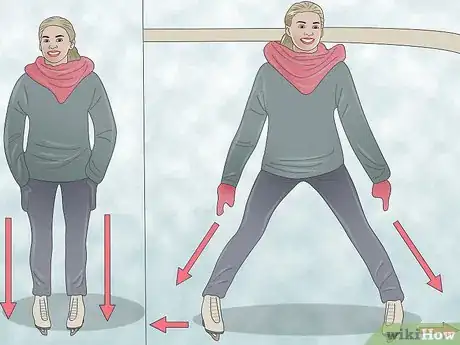
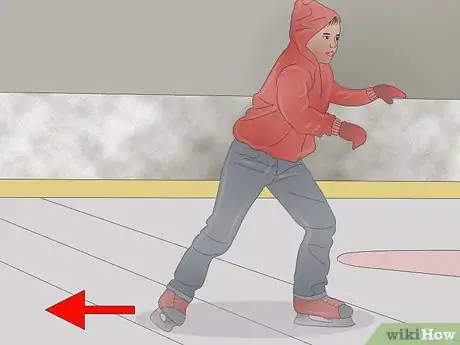
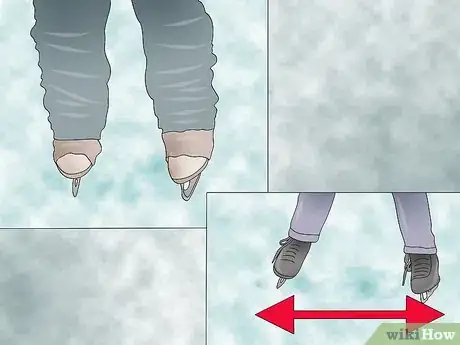
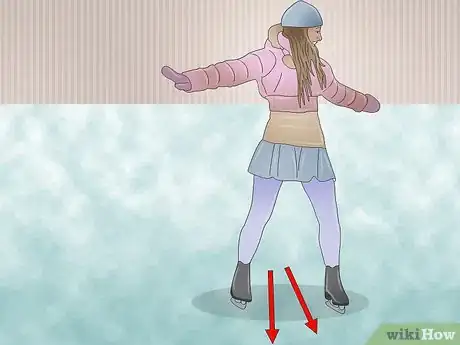
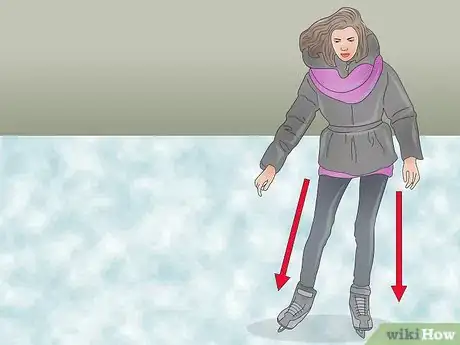

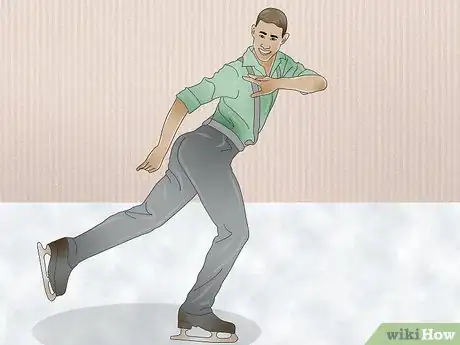
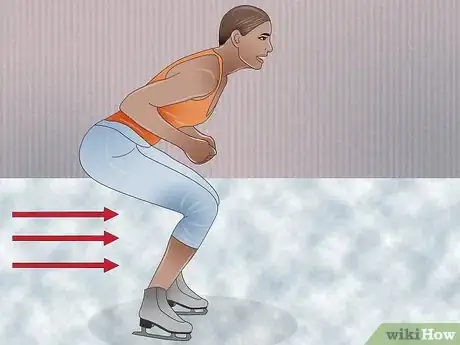

-Step-14.webp)






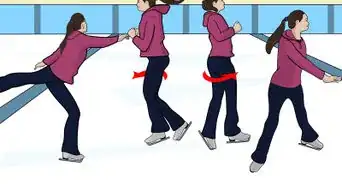
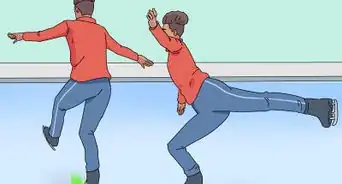

-Step-14.webp)






































